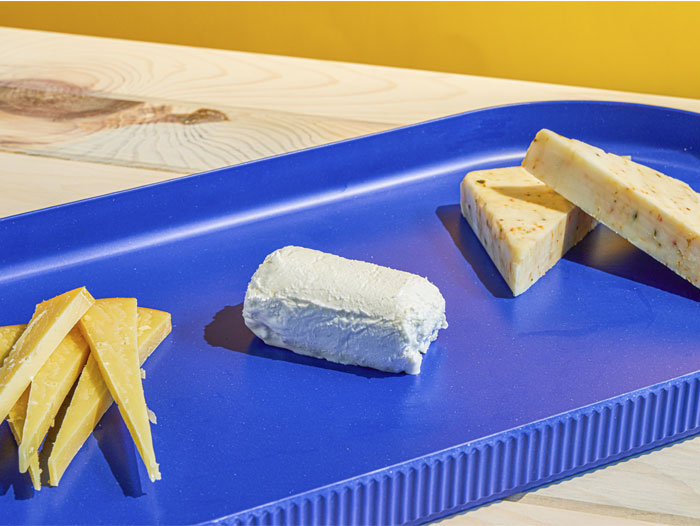Goat Cheese vs. Cow Cheese: The Nuances Retailers Need to Know
August 16, 2023 | 4 min to read
In the evolving retail landscape, understanding consumer preferences is essential, particularly regarding the quality and nutritional value of specialty cheese. A 2022 survey revealed that 70% of consumers feel confused about nutritional information, especially when comparing goat cheese to traditional cow cheese. Retailers can capitalize on this confusion by educating shoppers on the subtle differences and nutritional benefits of goat cheese, which may be easier to digest for those with lactose intolerance. Ultimately, informed guidance enhances the shopping experience and positions retailers as trusted sources of high-quality products.

In the dynamic retail landscape, understanding consumer preferences and catering to the increasing emphasis on an ingredient’s quality and nutritional value is crucial. According to a 2022 survey conducted by the International Food Information Council, 70% of respondents are confused about nutritional information because it seems to keep changing. What’s more, the specialty cheese category offers a myriad of choices, which can lead to further confusion among consumers who lack knowledge about key distinctions between similar-looking products. This can be especially true when it comes to choosing a goat cheese product, which is far less common than traditional cow cheese options.
This lack of understanding presents a valuable opportunity for retailers to serve as trusted advisors. By proactively addressing common questions consumers have about goat cheese—such as its nutritional value compared to similar looking cow cheeses—retailers can help bridge the knowledge gap, empower consumers to make informed decisions, and guide them in selecting the right product for their dietary preferences.
To help debunk myths, offer education and clarification, and solidify the retailer’s position as a provider of high-quality, health-conscious products, here are two key questions retailers should know how to address:
What’s The Difference Between Goat Cheese and Cow Cheese?
Admittedly, comparing the flavor of goat cheese to cow cheese is tricky. Some differences between the types are subtle, others are significant, and the quality of production will always influence the results. Because there are so many variables affecting taste, it is impossible to make a broad claim about the difference in taste between goat cheeses and cow cheeses. Instead, retailers are encouraged to acquaint themselves with all the different cheese varieties within their offerings. A comprehensive understanding of each cheese’s flavor profile will emerge through sampling diverse product types, brands, and flavors, thereby enhancing a retailer’s ability to effectively guide consumers at the point of purchase.
Beyond taste, it’s important to understand how goat cheese nutritionally compares to cow cheese. Acknowledging the wide variety of options available in both cheese categories, comparison is best done with products that are most similar.
Comparing the nutritional content in goat milk cheddar cheese to that of its cow counterpart will show the two options are fairly similar. Goat cheese has a slight edge in areas such as protein, carbohydrates, calcium, and vitamin A content. In contrast, cow cheese scores slightly higher in fat content. Nevertheless, these minor differences notwithstanding, both cow and goat cheese support ketogenic diets and recipes prioritizing health-conscious ingredients.

Is Goat Cheese a Good Option for Consumers with Dairy Intolerance?
While goat milk and cow milk are both dairy products, the two exhibit subtle differences in their lactose content. According to a 100-year review evaluating advances in goat milk research published in the Journal of Dairy Science, goat milk is comprised of 4.2% lactose while cow milk is closer to 5%. Although not conclusively proven, some consumers who are sensitive to lactose find this difference noteworthy and anecdotally prefer goat cheese when available.
In addition to this variance in lactose content, goat milk stands apart due to it containing just one type of beta casein protein—A2 beta—while cow milk contains both A1 and A2. Acknowledged for a gentler impact on digestion, the presence of only the A2 beta casein protein positions goat cheese as a compelling alternative for consumers that find cow milk products a bit difficult to digest.
For consumers who are curious about the potential digestive benefits of goat cheese, Michigan State University Extension recommends individuals with a dairy intolerance explore testing to see if goat milk products are suitable for their dietary needs.
Understand Your Audience: Catering to Consumer Preferences and Needs in the Cheese Aisle
While educating consumers is important, it’s equally important to know your customer. Certain individuals with dietary restrictions may prefer the attributes of goat cheese compared to the traditional cow cheeses available. For everyday foodies and cheese mongers, cheese is glorious cheese regardless of which dairy animal it comes from. At the end of the day, the all-important similarity between goat cheese and cow cheese is when they’re made well, they’re delicious.
With cheese being among the top 10 specialty food and beverage categories for 2022 in retail sales, it’s up to retailers to keep that momentum going. By continuing to offer comprehensive insights and address consumers’ questions leading up to the point of sale, retailers can help navigate the complexities of the specialty cheese landscape. This proactive approach not only facilitates informed consumer decision making but reinforces the retailer’s position as a purveyor of high-quality, health-conscious products, thus viewed as grocer of choice.
